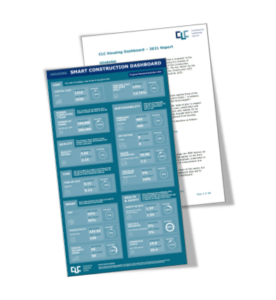Our fourth dashboard and data is aimed at showing evidence of the sectors performance. We continually aim to create knowledge and evidence to assist financial, operational, technical functions to enable better decisions to be made when designing, contracting, and delivering new housing stock. We aim to create connections between the different data and produce insight that will improve the sector performance.
This 2021 data Dashboard has been developed with data developed by BCIS, RICS, BRE, Cast, NHBC, CITB, LC Journey, Mott MacDonald and Ekkist and builds on the previous knowledge of the sector and performance.
The connections between the data, suggest that the sector became less efficient in 2021, despite the increase in material usage per home, and the speed of delivery of homes being marginally increased The reasons for this are unclear, but perhaps the constraints on skills and materials, from a disrupted supply base had an impact on time and performance.
Volumes of homes were down in year – market volumes decreased by 12%, disrupted by the pandemic impact on sales and supply of material in the first quarter of 2021. The supply chain material costs increased, and this further impacted supply of homes.
Healthy new homes expanded at a great rate – our stringent health and wellbeing measure, whilst low 0.5% of the volume of new homes, in 2020 accelerated to 2% of the new homes in 2021. This measure, representing a high health comfort as a proportion of new homes is encouraging and represents a step forward in the conditions for people, and the future of our housing.
Cost – costs continued to be linked to material and labour costs, increasing in year by 6%, linked to material inflation price increases. The increase in materials used (higher use of assembled systems offsite) appeared to not have a substantive impact on cost.
Waste generated increased by 15% suggesting that the sector became less efficient in practice, perhaps due to the significant volume increase, this correlates broadly to the slow delivery of homes taking longer to deliver homes per m2.
Digital maturity was significantly improved across the sector, improving by over 30%. Whilst digital maturity is improving across the construction sector, something to be celebrated, this housing data suggests that we are not seeing sufficient efficiency benefits, yet.
MMC policies started to make an impact– We started to see PMV specified as a requirement, at 55% – Pre-manufactured value (PMV) was estimated to move from 40% to 42% representing increased material fabrication of site, as a proportion of the overall cost of delivering new homes.
Safety improved markedly, achieving the 2025 target in 2021, and an improved of 20% on 2020. The sector learnt a lot about safety during the pandemic period, and it is hoped that this is a lasting operational and cultural changes for the sector.
Quality of homes marginally improved, 1%, using the new NHBC Quality index. Focus on quality and customer satisfaction appears to have had an impact on the finished product.
Apprenticeships – a measure of project based social value, reduced by 13%.Perhaps a long-term impact of the attractiveness of the housing market to encourage new skills. This is of concern, and points towards a need to continually focus on productivity of the sector.
Download the new Smart Construction Dashboard
Download the guidance document





